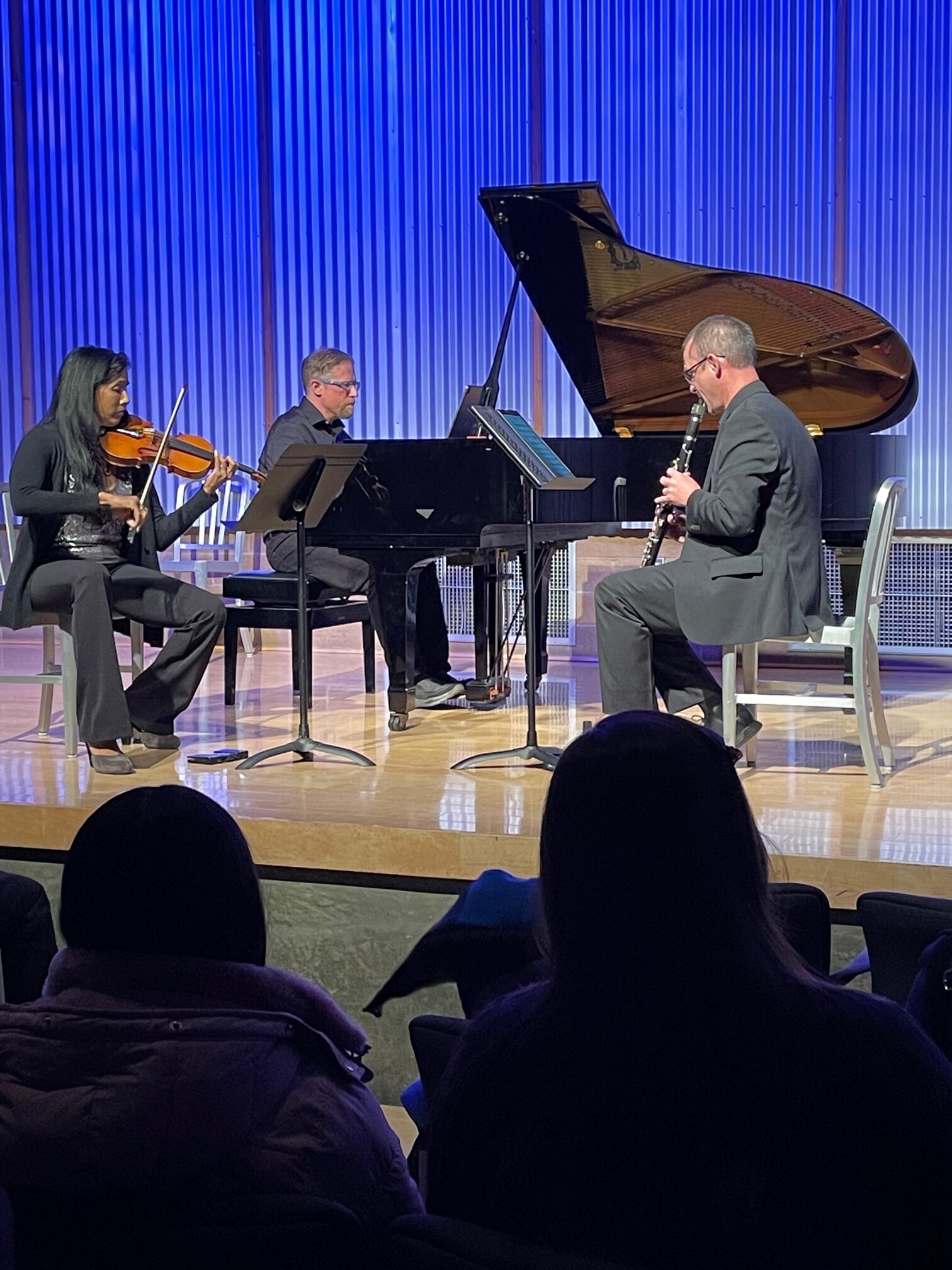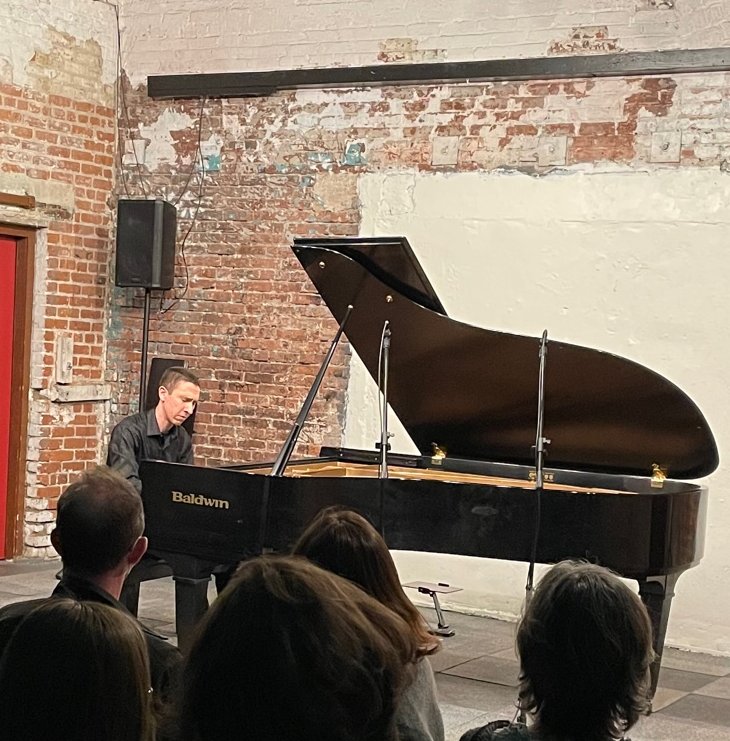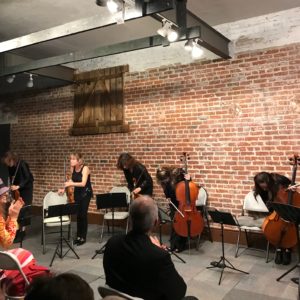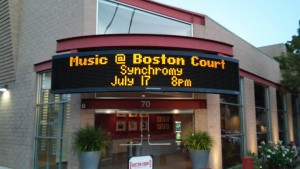
On Saturday, March 30, 2024 Brightwork newmusic presented I Will Learn to Love a Person, a concert of new music at Boston Court Pasadena. Brightwork musicians Aron Kallay, Stacey Fraser, Brian Walsh and Nick Terry contributed excellent performances of works by noted composers.. The six works on the concert program dated from 2012 to 2024 and featured unusual combinations of vocals, piano, woodwinds and percussion.
The first piece on the concert program was Wagon Wheeling (2012) by Tom Flaherty and written for Aron Kallay. This piece was inspired by those old western movies where the camera frame rates gave the illusion of wagon wheels running backwards. This was scored for piano and percussion and opened with a steady rhythm in the vibraphone reminiscent of a trotting horse. This increased in volume just before a sharp cymbal crash signaled the entrance of a independent piano line that add a fresh sense of movement. This developed into a nice groove that occasioned a relaxed, mellow feeling. As the piece proceeded, a strong beat in the piano engendered a more purposeful feeling. The precise playing of Aron Kallay on piano combined with Nick Terry’s animated percussion, produced an interesting texture. Differences in the rhythms between the two players evoked the perception of a new tempo, much as the variation in velocity of the wagon wheels in those old films.
A forceful series of solo passages on the tom-tom and cymbals added some power before falling back to a softer, mysterious feel from the piano and marimba. Wagon Wheeling is more about rhythm and pulse than harmony or melody, and there was an engaging variety to the many sounds produced by just the two players. With Wagon Wheeling Flaherty effectively deploys what is available from the sonic palette of piano and percussion.
The second work on the program was Murmurations (2018) by A.J. McCaffrey, scored for piano and clarinets. A murmuration is a large flock of birds who swarm together in close-order aerobatics, almost like a fast-moving cloud that darts off in unexpected directions. Murmurations opened with a bright arpeggio from the clarinet, evoking bird calls and a magical atmosphere. The piano supported in the lower registers and the clarinet line morphed into soft and sustained tones above. The arpeggio was repeated by the clarinet, but its opening optimism was offset by a series of dark chords in the piano. The contrast between the bright passages and the darker accompaniment created a sense of fast-moving uncertainty.
As the piece continued, the passages in the clarinet became progressively more agile and complex . As the dynamic increased, the clarinet culminated in a series of sharp shrieking sounds, expertly played by Brian Walsh with power and excellent control. Meanwhile, the piano persisted with chords in the lower registers. The clarinet seemed to be trying to break out from the uncertainty with a more subdued and lighter sound, but never quite managed to escape before a quiet finish ended the piece. Murmurations delivers a surprising amount of movement and emotion from the piano and clarinet duo.
Lost Borders, (2024) by Pamela Madsen, followed, and this is from the last act of Why Women Went West, her multi-media chamber opera. Why Women Went West is based on the story of Mary Austin Hunter, a 19th century mid-westerner who journeyed alone across the continent to California in the early days of the settlement in the American far west. The opera is partly about the dangers and rigors and of traveling cross country in that era, but more generally about Austin’s extended odyssey of self-discovery. The program notes state that the opera chronicles “ …Mary Austin’s escape from persecution to transformation of white woman’s privilege and passion for preservation of nature, history, and indigenous culture.” Lost Borders is a sort of summing up of Ms. Austin’s metamorphosis over her lifetime in the west.
Stacey Fraser has sung the soprano lead in Why Women Went West and has the skill and stamina to carry the part. Lost Borders opens with quiet, pensive chords in the piano and marimba, accompanied by a dark bass clarinet line. A briefly spoken narration opens the story. The soprano vocals begin, mostly in the middle registers, but turn quietly powerful – “Save me, O Lord…” is heard. As the piece continues, the instruments combine to build a darkening mood. Strong, solitary beats from the percussion add a bit of tension. Ms. Fraser’s expressive singing has to work against the somber texture in the accompaniment. For all of that, the scoring for just four instruments masterfully supports the complex and changing flow of emotions in the text. Lost Borders is only a small part of an opera worth experiencing in its entirety.
After a short intermission, Xarja (2017) by Kareem Roustom was next, and this was scored, unusually, for voice and percussion. The text is taken from from the “Waterfire” muwashshah by Al’Ama al-Tuttli (d. 1126 Tudela, Spain) and other poets of that era. ‘Xarja’ is a Spanish translation of the Arabic word for ‘exit’ or ‘final’. In the program notes the composer writes that, in some ways, the piece is a metaphor for the present evolution of music: “Like the grief stricken lover, ‘death is my state’ can be applied to the musical language I’ve been using for sometime. However, out of ‘death’ comes ‘rebirth’ and the opportunity to begin anew.”
A slow beat on a hand drum opens Xarja and this develops into a pleasant groove. The soprano voice entered in a quiet, conventional line and there was an engaging interplay between the vocals and the percussion. The tempo increases and the tones of the vibraphone are heard as the voice rises in dynamic and climbs higher in pitch. Drama was added with a soaring soprano line from Ms. Fraser, the result of equal parts of vocal power and control. The complex texture was a good contrast to the opening and impressive given just the two performers. At one point Nick Terry was bowing the vibraphone plates and this proved to be both exotic and very expressive. Towards the end of the piece the performers were clapping and stamping their feet in a stirring finish. Xarja manages to extract the maximum passion from the unorthodox pairing of voice and percussion.
A Sonatina (2016) by Bill Alves followed, performed by Aron Kallay and Stacey Fraser. Inspired by “A Sonatina Followed by Another”, a 1921 poem by Gertrude Stein, the composer writes in the program notes, “I have extracted lullaby-like bits of the text that often seem to refer to her life partner, Alice Toklas.” A Sonatina opened with a nice running piano line and a solid vocal entrance that lifted up sustained tones. There was an intriguing feel to this and the format aided comfortably accessible listening. The piece darkened somewhat as the running piano line slipped into a lower register. The drama increased as the piece proceeded, and when combined with the vocals, a lovely overall sound was the result. A Sonatina is skillfully crafted music with this performance by Fraser and Kallay, equaling the intentions of the composer.
The final piece on the concert program was I Will Learn to Love a Person (2013), by Chris Cerronne. This is a song cycle about personal relationships as expressed in music with each section quickly following the last after a brief silence. This was performed by Aron Kallay on piano, Brian Walsh playing clarinets, Nick Terry on percussion and Stacey Fraser, soprano. Two quiet notes from the piano opened the piece with the vibraphone entering in the same register. The resulting mix was immediately effective and had a haunting feel. The soprano enters with words about a relationship, deepening the mystery. The clarinet joins in, supporting the vocals with a sequence of sustained pitches.
A series of continuing tremolos in the piano and clarinet followed, producing a pleasingly active texture. The voice enters, now stronger and with more confidence. As the piece proceeds, the dynamics become softer as the soprano sings quietly declarative vocals against sustained notes from the rest of the ensemble. The many emotions present in personal relationships are heard throughout this piece, always with a skillful and refined nuance. Later, the interweaving of the voice and instruments is beautifully expressive. After a short return to the tremolo texture, the emotional energy increases as the voice rises higher in pitch and stronger in tone. The close coordination of the performers and their attention to detail make I Will Learn to Love a Person an exquisitely intimate artistic journey.
This concert confirms Brightwork newmusic as one of the top ensembles performing in Los Angeles. The addition of vocalist Stacey Fraser this season has expanded their artistry to new levels.




